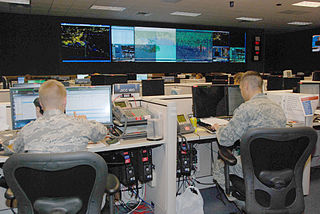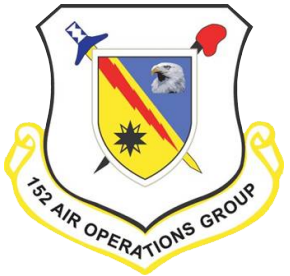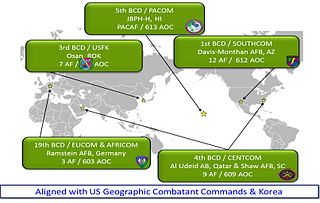Related Research Articles
Military doctrine is the expression of how military forces contribute to campaigns, major operations, battles, and engagements. A military doctrine outlines what military means should be used, how forces should be structured, where forces should be deployed, and the modes of cooperation between types of forces. "Joint doctrine" refers to the doctrines shared and aligned by multinational forces or joint service operations.

The Thirteenth Expeditionary Air Force is a provisional numbered air force of the United States Air Force Pacific Air Forces (PACAF). It is headquartered at Hickam Air Force Base, Joint Base Pearl Harbor–Hickam on the island of Oahu, Hawaii. It has never been stationed in the continental United States.

Eighteenth Air Force (Air Forces Transportation) (18 AF) is the only Numbered Air Force (NAF) in Air Mobility Command (AMC) and one of the largest NAFs in the United States Air Force. 18 AF was activated on 28 March 1951, inactivated on 1 January 1958, and re-activated on 1 October 2003. 18 AF is headquartered at Scott Air Force Base, Illinois.
Network-centric warfare, also called network-centric operations or net-centric warfare, is a military doctrine or theory of war that aims to translate an information advantage, enabled partly by information technology, into a competitive advantage through the computer networking of dispersed forces. It was pioneered by the United States Department of Defense in the 1990s.
An Operation Order, often abbreviated to OPORD, is a plan format meant to assist subordinate units with the conduct of military operations. An OPORD describes the situation the unit faces, the mission of the unit, and what supporting activities the unit will conduct in order to achieve their commander's desired end state. Normally an OPORD is generated at the battalion, regimental, brigade, divisional, or corps headquarters and disseminated to its assigned or attached elements. The issuance of an OPORD triggers subordinate unit leadership to develop orders specific to the role or roles that the unit will assume within the operation. This more narrowly focused order borrows information from the original, or base, order and adds additional details that pertain more to the minutiae of the actions a unit is tasked to conduct in support of the overarching operation.

Command and control is a "set of organizational and technical attributes and processes ... [that] employs human, physical, and information resources to solve problems and accomplish missions" to achieve the goals of an organization or enterprise, according to a 2015 definition by military scientists Marius Vassiliou, David S. Alberts, and Jonathan R. Agre. The term often refers to a military system.

The Combined Space Operations Center (CSpOC) is a U.S.–led multinational space operations center that provides command and control of space forces for the United States Space Command under the United States Space Force component field command United States Space Forces – Space. The CSpOC is located at Vandenberg Space Force Base.

An Air Operations Center (AOC) is a type of command center used by the United States Air Force (USAF). It is the senior agency of the Air Force component commander to provide command and control of air operations.

The 152d Air Operations Group is a unit of the New York Air National Guard, stationed at Hancock Field Air National Guard Base, Syracuse, New York. If called into active federal service, the group is gained by United States Air Forces Europe (USAFE).

The Hawaii Air National Guard (HI ANG) is the aerial militia of the U.S. state of Hawaii. It is a reserve of the United States Air Force and along with the Hawaii Army National Guard, an element of the Hawaii National Guard.

The United States Air Force's 281st Combat Communications Group was a Rhode Island Air National Guard combat communications unit located in North Smithfield, Rhode Island, United States.
DOTMLPF is an acronym for doctrine, organization, training, materiel, leadership and education, personnel, and facilities. It is used by the United States Department of Defense and was defined in the Joint Capabilities Integration Development System, or JCIDS Process as the framework to design what administrative changes and/or acquisition efforts would fill a capability need required to accomplish a mission. Because combatant commanders define requirements in consultation with the Office of the Secretary of Defense (OSD), they are able to consider gaps in the context of strategic direction for the total US military force and influence the direction of requirements earlier in the acquisition process, in particular, materiel.
Joint Forces Air Component Commander (JFACC) is a United States Department of Defense doctrinal term. It is pronounced "Jay-Fack".
Joint Force Land Component Commander (JFLCC), is a United States Department of Defense doctrinal term. It is pronounced "Jay-Flick".
Joint Force Maritime Component Command (JFMCC), is a United States Department of Defense doctrinal term.

The 682 Air Support Operations Squadron is an operational component of the Tactical Air Control System. The 682 DASOS is assigned to the 18th Air Support Operations Group, Pope Field, North Carolina, which is a direct reporting agency of 9th Air Force.
The Joint Theater Level Simulation (JTLS) is used to simulate joint, combined, and coalition civil-military operations at the operational level. Used for civil/military simulations and humanitarian assistance/disaster relief (HA/DR) scenarios, JTLS is an interactive, computer-assisted simulation that models multi-sided air, ground, and naval resources with logistical Special Operation Forces (SOF) and intelligence support. The primary purpose of JTLS is to create a realistic environment in which agency staff can operate as they would within a real-world or operational situation.also information.A training audience conducts a scenario or event to practice their ability to coordinate various staff functions.

The Battlefield Coordination Detachment (US Army), or BCD, is the senior United States Army liaison element of the Army Air Ground System. The BCD serves as a bridge between the senior US Army headquarters element and the senior Air Force headquarters in each respective US combatant command or theater of operations. The BCD enables the coordination of Army-Air Force mission command, fire support, integrated air and missile defense, intelligence sharing, airspace management, and airlift. Additional space, cyber, and electronic warfare augmentation allow the BCD to further enable the designated Army force commander across the complete spectrum of warfare.

The 601st Air Operations Center is an active unit of the United States Air Force, assigned to the First Air Force and stationed at Tyndall Air Force Base, Florida. The unit plans, directs, and assesses air operations for the North American Aerospace Defense Command (NORAD), and the United States Northern Command (NORTHCOM), as the operations hub for First Air Force. It provides aerospace warning and control for NORAD Defensive Counter Air (DCA) activities. It also directs Air Force activities in support of NORTHCOM homeland security and civil support missions. The 601 AOC directs all air sovereignty activities for the continental United States.
References
- ↑ "Combat Orders Foundations B2B0287 Student Handout" (PDF). Marine Corps Training Command. Retrieved October 7, 2024.
- ↑ Conner, Kevin; Labertson, Paul; Roberson, Matthew. "Analyzing the Air Operations Center (AOC) Air Tasking Order (ATO) Process Using Theory of Constraints (TOC)" (PDF). Defense Technical Information Center. Archived (PDF) from the original on November 6, 2016. Retrieved 20 October 2016.
- ↑ Winkler, Robert. "The Evolution of the Joint ATO Cycle" (PDF). Defense Technical Information Center. Archived from the original on September 3, 2012. Retrieved 20 October 2016.
- ↑ Rosenkranz, Keith (2002). Vipers in the Storm: Diary of a Gulf War Fighter Pilot. New York: McGraw-Hill. pp. 311, 313. ISBN 978-0071400404.